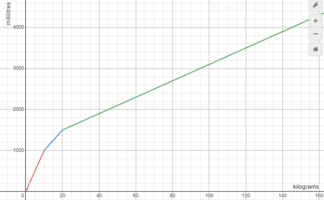greedylobster
New member
- Joined
- Sep 17, 2022
- Messages
- 4
Hello all, this is rather embarrassing and the answer is simple, but it's been a long time since I did maths.
I'm trying to write a formula that would allow to "process"a number.
This is how it works:
there is a number, say 50
within that 50, values 1-10 are multiplied by 100
values 11-20, are multiplied by 50
anything above 20 (i.e. 21 and over), multiplied by 20 with the final answer being the sum of the three
Example:
5
5 x 100 = 500
15
10 x 100 = 1000
5 x 50 = 250
1000 + 250 = 1250
20
10 x 100 = 1000
10 x 50 = 500
1000 + 500 = 1500
25
10 X 100 = 1000
10 x 50 = 500
5 x 20 = 100
1000 + 500 + 100 = 2600
is it possible to have a "universal" formula that would cover the process?
I'd be greatful for any help/ direction...
I'm trying to write a formula that would allow to "process"a number.
This is how it works:
there is a number, say 50
within that 50, values 1-10 are multiplied by 100
values 11-20, are multiplied by 50
anything above 20 (i.e. 21 and over), multiplied by 20 with the final answer being the sum of the three
Example:
5
5 x 100 = 500
15
10 x 100 = 1000
5 x 50 = 250
1000 + 250 = 1250
20
10 x 100 = 1000
10 x 50 = 500
1000 + 500 = 1500
25
10 X 100 = 1000
10 x 50 = 500
5 x 20 = 100
1000 + 500 + 100 = 2600
is it possible to have a "universal" formula that would cover the process?
I'd be greatful for any help/ direction...

